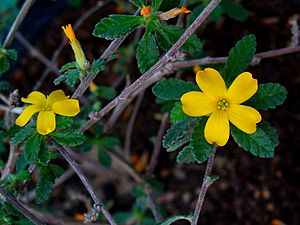Turnera diffusa facts for kids
Quick facts for kids Turnera diffusa |
|
|---|---|
 |
|
| Turnera diffusa var. aphrodisiaca | |
| Scientific classification | |
| Genus: |
Turnera
|
| Species: |
diffusa
|
| Varieties | |
|
T. d. var. aphrodisiaca (G.H.Ward) Urb. |
|
| Synonyms | |
|
List
|
|
Turnera diffusa, also known as damiana, is a small, woody plant. It grows naturally in southern Texas in the United States, Central America, Mexico, South America, and the Caribbean. This plant is part of the Passifloraceae family.
Damiana is a shrub that produces small, sweet-smelling flowers. These flowers bloom in the summer. After the flowers, the plant grows fruits that taste a bit like figs. The shrub has a strong, spicy smell, similar to chamomile. This smell comes from special oils inside the plant.
What Damiana Is Used For
Damiana is an ingredient in a traditional Mexican liqueur. This drink is sometimes used instead of triple sec in margaritas. Some stories say that damiana was in the very first margarita recipe. The damiana margarita is quite popular in the Los Cabos area of Mexico.
In the 1800s, damiana was found in some old-fashioned medicines. One example was Pemberton's French Wine Coca. The leaves of damiana were not included in Coca-Cola, which was a non-alcoholic version of that product.
Damiana in Nature
T. diffusa is a special plant for the Mexican Fritillary butterfly (Euptoieta hegesia). This means the butterfly uses the damiana plant for food or to lay its eggs. It is an important part of their habitat.
Mistakes in Selling Damiana
Sometimes, when people buy damiana plants or seeds, they might get the wrong plant by mistake. Often, it turns out to be Turnera ulmifolia, which is also called "False Damiana." This is a plant that looks similar but is different.
Scientists have noticed this common mix-up. It has caused confusion for both plant experts and people who just enjoy gardening. Even though T. ulmifolia looks like damiana, its chemicals and traditional uses are not the same.
Real T. diffusa has woody stems. Its small, grayish-green leaves are about 13 to 16 millimeters long. They are also 4.5 to 5.5 millimeters wide and smell strong when you crush them. T. ulmifolia has softer stems and larger, blue-green leaves. Its leaves have jagged edges and a pointed tip, and they do not smell as strong.
However, one study showed that this mix-up mostly happens with plants sold for gardening. Most damiana products sold as herbs usually contain the correct T. diffusa plant.
See also
 In Spanish: Hierba de la pastora para niños
In Spanish: Hierba de la pastora para niños


